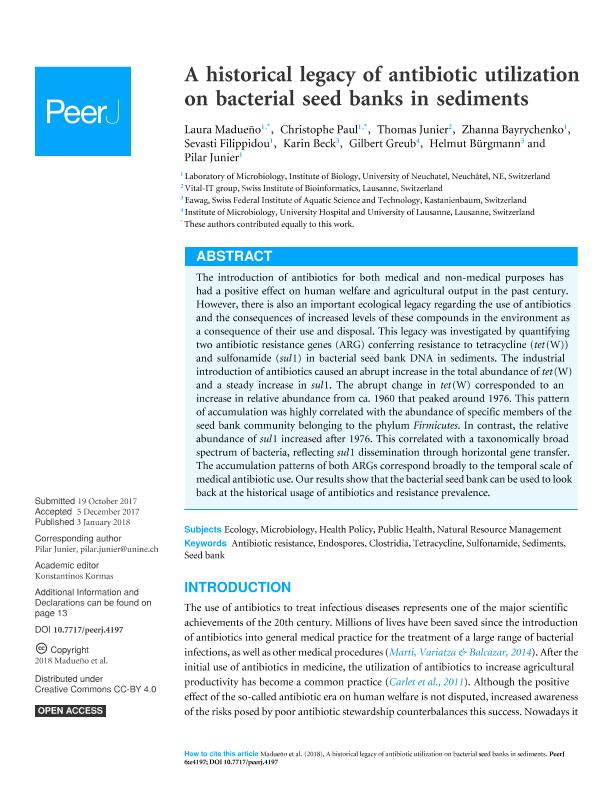Artículo
A historical legacy of antibiotic utilization on bacterial seed banks in sediments
Madueño, Laura ; Paul, Christophe; Junier, Thomas; Bayrychenko, Zhanna; Filippidou, Sevasti; Beck, Karin; Greub, Gilbert; Bürgmann, Helmut; Junier, Pilar
; Paul, Christophe; Junier, Thomas; Bayrychenko, Zhanna; Filippidou, Sevasti; Beck, Karin; Greub, Gilbert; Bürgmann, Helmut; Junier, Pilar
 ; Paul, Christophe; Junier, Thomas; Bayrychenko, Zhanna; Filippidou, Sevasti; Beck, Karin; Greub, Gilbert; Bürgmann, Helmut; Junier, Pilar
; Paul, Christophe; Junier, Thomas; Bayrychenko, Zhanna; Filippidou, Sevasti; Beck, Karin; Greub, Gilbert; Bürgmann, Helmut; Junier, Pilar
Fecha de publicación:
01/2018
Editorial:
PeerJ
Revista:
PeerJ
ISSN:
2167-8359
Idioma:
Inglés
Tipo de recurso:
Artículo publicado
Clasificación temática:
Resumen
The introduction of antibiotics for both medical and non-medical purposes has had a positive effect on human welfare and agricultural output in the past century. However, there is also an important ecological legacy regarding the use of antibiotics and the consequences of increased levels of these compounds in the environment as a consequence of their use and disposal. This legacy was investigated by quantifying two antibiotic resistance genes (ARG) conferring resistance to tetracycline (tet(W)) and sulfonamide (sul1) in bacterial seed bank DNA in sediments. The industrial introduction of antibiotics caused an abrupt increase in the total abundance of tet(W) and a steady increase in sul1. The abrupt change in tet(W) corresponded to an increase in relative abundance from ca. 1960 that peaked around 1976. This pattern of accumulation was highly correlated with the abundance of specific members of the seed bank community belonging to the phylum Firmicutes. In contrast, the relative abundance of sul1 increased after 1976. This correlated with a taxonomically broad spectrum of bacteria, reflecting sul1 dissemination through horizontal gene transfer. The accumulation patterns of both ARGs correspond broadly to the temporal scale of medical antibiotic use. Our results show that the bacterial seed bank can be used to look back at the historical usage of antibiotics and resistance prevalence.
Archivos asociados
Licencia
Identificadores
Colecciones
Articulos(CINDEFI)
Articulos de CENT.DE INV EN FERMENTACIONES INDUSTRIALES (I)
Articulos de CENT.DE INV EN FERMENTACIONES INDUSTRIALES (I)
Citación
Madueño, Laura; Paul, Christophe; Junier, Thomas; Bayrychenko, Zhanna; Filippidou, Sevasti; et al.; A historical legacy of antibiotic utilization on bacterial seed banks in sediments; PeerJ ; PeerJ; 2018; 1; 1-2018; 2-19
Compartir
Altmétricas



